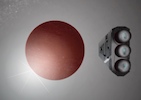AustLit

-
An in-progress glossary to provides definitions of speculative-fiction terms and genres.
Alternate history: a genre in which one historical event or a series of events occur differently than in reality, leading to an alternate future. Such works usually contain some kind of "what if" question (e.g., What if Ned Kelly had never been caught at Glenrowan?). A related sub-genre is Uchronia, or uchronian works, a portmanteau of utopia (no-place) and chronos (time): uchronian works differ from alternate history in that they occur in a hypothetical or fictional time, rather than within Earth history.
Example: graphic novel The Diemenois.
Anthropological science fiction:
Apocalyptic and post-apocalyptic science fiction:
Black powder fantasy: fantasy early modern period, usually the 16th or 17th centuries, often in Europe. Rather than the sword-orientated medievalist fantasies, black powder fantasy focuses on early gun technologies.
Example: novel The Game Bird.
Cyberpunk:
Dying Earth: science fiction / fantasy works set at the end of life on Earth (or occasionally at the end of the universe itself). The sub-genre takes its name from Jack Vance's 1950 collection The Dying Earth, but its origins can be traced to the end of the nineteenth century.
Example: the anthology Earth Is But a Star : Excursions Through Science Fiction to the Far Future.
Fantasy of manners: fantasy works modelled in part on comedies of manners, and taking place within rigid, hierarchical social structures. Authors of fantasy of manners draw heavily on influences such as Jane Austen, Alexandre Dumas, P.G. Wodehouse, and Georgette Heyer.
Example: the collected work New Ceres Nights.
Gunpowder fantasy: see black powder fantasy.
Hard science fiction (hard SF): science fiction novels with an emphasis on scientific accuracy, attention to detail, or both. With the rise of soft science fiction, 'hard science fiction' can also refer to the works' reliance on the so-called 'hard' sciences (physics, chemistry, and so on). See also soft science fiction.
High fantasy: Works set in an alternative, secondary world (magical and fictional), rather than in the 'real' or 'primary' world ('low fantasy' works). The term 'High fantasy' was coined by American author Lloyd Alexander in 1971. Also called secondary world fantasy.
Example: Cory Daniells's The T'En Trilogy.
Lost civilisation narratives / lost world stories: Science fiction or fantasy works that include the discovery of a people, city, or civilisation out of time or out of place (or perhaps both). Despite earlier utopian / dystopian works (e.g. Utopia, Thomas More) and satirical travel narratives (e.g., Gulliver's Travels, Jonathan Swift), critics generally trace the beginning of lost worlds as a sub-genre of speculative fiction to the late nineteenth century, usually with H. Rider Haggard's King Solomon's Mines.
Example: James Francis Dwyer wrote a number of lost civilisation novels, including The Spotted Panther.
Low fantasy: as opposed to 'high fantasy', low fantasy works are set in the 'real' world, with the inclusion of magical elements. Patricia Wrightson's The Nargun and the Stars is an example of low fantasy.
Example: Alis Franklin's Liesmith.
Military science fiction: Science fiction works that focus on characters who are part of a military organisation, and often concentrates on science-fiction weaponry. Military SF often overlaps with survivalist stories.
Example: the SNAFU anthologies.
Mundane science fiction: science fiction set on Earth or its near neighbours, with plausible science and technology. Mundane science fiction is categorised by an absence of interstellar travel or alien encounters. Conceptualised by, among others, English-based author Geoff Ryman, mundane science fiction is a counterpoint to extravagant Atomic Era stories.
Secondary world fantasy: See High fantasy.
Slipstream: fiction that crosses the boundaries of science fiction, fantasy, and literary fiction. Not all slipstream fiction contains speculative fiction elements, and the category is usually positioned somewhere between speculative fiction and mainstream fiction.
Soft science fiction (soft SF): a paired term to 'hard science fiction', soft science fiction can either be (a) works with less realistic science elements or (b) works that explore the so-called 'soft' sciences (anthropology, sociology, psychology, and so on).
Steampunk: Science fiction or fantasy works that incorporate aspects of nineteenth-century industrial design and technology. Steampunk is often but not exclusively set in alternate-world versions of Victorian England or America's Wild West. For a detailed listing of the various steampunk forms and associated subgenres, see Beyond Goggles and Corsets.
Example: Bec McMaster's London Steampunk series.
Timeslip: Fantasy works in which characters slip back, usually through the intervention of an object or a person from that time. Timeslip novels differ from the time travel novels of hard SF in that there is usually no scientific explanation for the time travel.
Example: Belinda Murrell regularly writes timeslip novels, including The Locket of Dreams. Australian classic Playing Beatie Bow is also a timeslip novel.
Transhumanism: The transformation of the human condition through technologies that enhance longevity, physical or intellectual abilities, or psychological capacities. Often an aspect of future-set science fiction.
Example: Graham Storrs's The Credulity Nexus.
You might be interested in...



